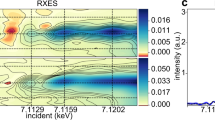Abstract
ONE of the chief reasons for the low intensity of the X-ray lines emitted by light atoms is the low fluorescent yield of the X-ray emission by such atoms. As predicted by Rosseland and first shown by Auger, excited atoms when reorganising can dispose of their excess energy either by emitting X-ray quanta or by giving off photoelectrons. When the latter process prevails, the yield of X-ray emission is low, and vice versa. The magnitude of the yield can be determined by counting the number of photo-electrons1 given off by the atoms when leaving the excited state, or by comparing the intensity of the exciting and the excited radiation.
This is a preview of subscription content, access via your institution
Access options
Subscribe to this journal
Receive 51 print issues and online access
$199.00 per year
only $3.90 per issue
Buy this article
- Purchase on Springer Link
- Instant access to full article PDF
Prices may be subject to local taxes which are calculated during checkout
Similar content being viewed by others
References
P. Auger, Ann. Phys., 6, 183; 1926.
Comp. especially L. Martin, Proc. Roy. Soc., A, 115, 420; 1927. A. H. Compton, Phil. Mag., VII, 8, 961; 1929. G. L. Locher, Phys. Rev., 40, 484; 1932. M. Haas, Ann. Phys., 16, 473; 1933. D. K. Berkey, Phys. Rev., 45, 437; 1934.
G. v. Hevesy and E. Alexander, Die Naturwissenschaften, 19, 825; 1931.
Author information
Authors and Affiliations
Rights and permissions
About this article
Cite this article
HEVESY, G., LAY, H. Fluorescent Yield of X-Ray Emission. Nature 134, 98–99 (1934). https://doi.org/10.1038/134098b0
Issue Date:
DOI: https://doi.org/10.1038/134098b0
Comments
By submitting a comment you agree to abide by our Terms and Community Guidelines. If you find something abusive or that does not comply with our terms or guidelines please flag it as inappropriate.



